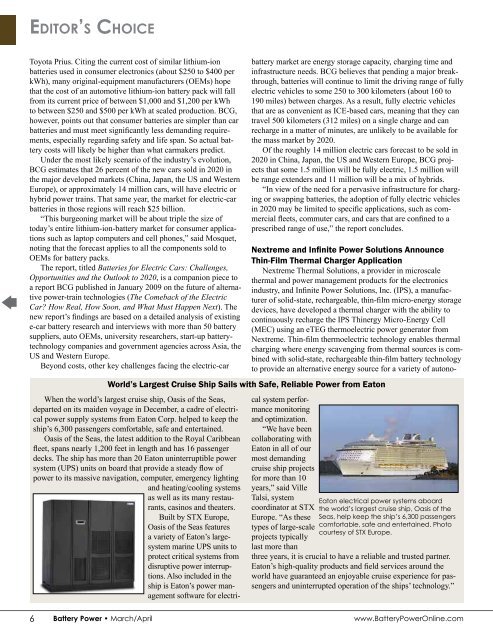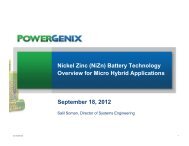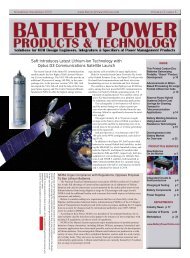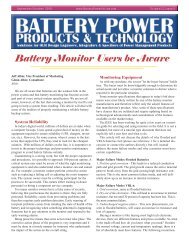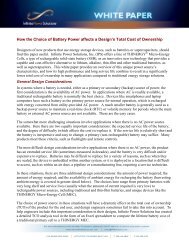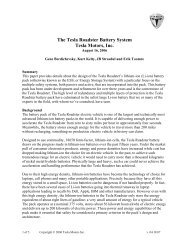Battery Management Systems - Battery Power Magazine
Battery Management Systems - Battery Power Magazine
Battery Management Systems - Battery Power Magazine
You also want an ePaper? Increase the reach of your titles
YUMPU automatically turns print PDFs into web optimized ePapers that Google loves.
Editor’s Choice<br />
Editor’s Choice<br />
Toyota Prius. Citing the current cost of similar lithium-ion<br />
batteries used in consumer electronics (about $250 to $400 per<br />
kWh), many original-equipment manufacturers (OEMs) hope<br />
that the cost of an automotive lithium-ion battery pack will fall<br />
from its current price of between $1,000 and $1,200 per kWh<br />
to between $250 and $500 per kWh at scaled production. BCG,<br />
however, points out that consumer batteries are simpler than car<br />
batteries and must meet significantly less demanding requirements,<br />
especially regarding safety and life span. So actual battery<br />
costs will likely be higher than what carmakers predict.<br />
Under the most likely scenario of the industry’s evolution,<br />
BCG estimates that 26 percent of the new cars sold in 2020 in<br />
the major developed markets (China, Japan, the US and Western<br />
Europe), or approximately 14 million cars, will have electric or<br />
hybrid power trains. That same year, the market for electric-car<br />
batteries in those regions will reach $25 billion.<br />
“This burgeoning market will be about triple the size of<br />
today’s entire lithium-ion-battery market for consumer applications<br />
such as laptop computers and cell phones,” said Mosquet,<br />
noting that the forecast applies to all the components sold to<br />
OEMs for battery packs.<br />
The report, titled Batteries for Electric Cars: Challenges,<br />
Opportunities and the Outlook to 2020, is a companion piece to<br />
a report BCG published in January 2009 on the future of alternative<br />
power-train technologies (The Comeback of the Electric<br />
Car How Real, How Soon, and What Must Happen Next). The<br />
new report’s findings are based on a detailed analysis of existing<br />
e-car battery research and interviews with more than 50 battery<br />
suppliers, auto OEMs, university researchers, start-up batterytechnology<br />
companies and government agencies across Asia, the<br />
US and Western Europe.<br />
Beyond costs, other key challenges facing the electric-car<br />
battery market are energy storage capacity, charging time and<br />
infrastructure needs. BCG believes that pending a major breakthrough,<br />
batteries will continue to limit the driving range of fully<br />
electric vehicles to some 250 to 300 kilometers (about 160 to<br />
190 miles) between charges. As a result, fully electric vehicles<br />
that are as convenient as ICE-based cars, meaning that they can<br />
travel 500 kilometers (312 miles) on a single charge and can<br />
recharge in a matter of minutes, are unlikely to be available for<br />
the mass market by 2020.<br />
Of the roughly 14 million electric cars forecast to be sold in<br />
2020 in China, Japan, the US and Western Europe, BCG projects<br />
that some 1.5 million will be fully electric, 1.5 million will<br />
be range extenders and 11 million will be a mix of hybrids.<br />
“In view of the need for a pervasive infrastructure for charging<br />
or swapping batteries, the adoption of fully electric vehicles<br />
in 2020 may be limited to specific applications, such as commercial<br />
fleets, commuter cars, and cars that are confined to a<br />
prescribed range of use,” the report concludes.<br />
World’s Largest Cruise Ship Sails with Safe, Reliable <strong>Power</strong> from Eaton<br />
When the world’s largest cruise ship, Oasis of the Seas,<br />
departed on its maiden voyage in December, a cadre of electrical<br />
power supply systems from Eaton Corp. helped to keep the<br />
ship’s 6,300 passengers comfortable, safe and entertained.<br />
Oasis of the Seas, the latest addition to the Royal Caribbean<br />
fleet, spans nearly 1,200 feet in length and has 16 passenger<br />
decks. The ship has more than 20 Eaton uninterruptible power<br />
system (UPS) units on board that provide a steady flow of<br />
power to its massive navigation, computer, emergency lighting<br />
and heating/cooling systems<br />
as well as its many restaurants,<br />
casinos and theaters.<br />
Built by STX Europe,<br />
Oasis of the Seas features<br />
a variety of Eaton’s largesystem<br />
marine UPS units to<br />
protect critical systems from<br />
disruptive power interruptions.<br />
Also included in the<br />
ship is Eaton’s power management<br />
software for electrical<br />
system performance<br />
monitoring<br />
and optimization.<br />
“We have been<br />
collaborating with<br />
Eaton in all of our<br />
most demanding<br />
cruise ship projects<br />
for more than 10<br />
years,” said Ville<br />
Talsi, system<br />
coordinator at STX<br />
Europe. “As these<br />
types of large-scale<br />
projects typically<br />
last more than<br />
Eaton electrical power systems aboard<br />
the world’s largest cruise ship, Oasis of the<br />
Seas, help keep the ship’s 6,300 passengers<br />
comfortable, safe and entertained. Photo<br />
courtesy of STX Europe.<br />
three years, it is crucial to have a reliable and trusted partner.<br />
Eaton’s high-quality products and field services around the<br />
world have guaranteed an enjoyable cruise experience for passengers<br />
and uninterrupted operation of the ships’ technology.”<br />
Nextreme and Infinite <strong>Power</strong> Solutions Announce<br />
Thin-Film Thermal Charger Application<br />
Nextreme Thermal Solutions, a provider in microscale<br />
thermal and power management products for the electronics<br />
industry, and Infinite <strong>Power</strong> Solutions, Inc. (IPS), a manufacturer<br />
of solid-state, rechargeable, thin-film micro-energy storage<br />
devices, have developed a thermal charger with the ability to<br />
continuously recharge the IPS Thinergy Micro-Energy Cell<br />
(MEC) using an eTEG thermoelectric power generator from<br />
Nextreme. Thin-film thermoelectric technology enables thermal<br />
charging where energy scavenging from thermal sources is combined<br />
with solid-state, rechargeable thin-film battery technology<br />
to provide an alternative energy source for a variety of autonomous,<br />
self-powered applications.<br />
The prototype thermal charger uses an array of 16 HV14<br />
modules in power generation mode to provide the 4.1 volts of<br />
electricity needed to charge the MEC to a fully charged state<br />
in approximately 20 minutes. At 0.5 millimeters high and each<br />
smaller than a sunflower seed, four of these HV14 power generators<br />
can replace a AA battery.<br />
Nextreme’s eTEG HV14 has demonstrated output power<br />
levels of >16 mW at ΔT of 70°C and >45 mW at ΔT of 120°C.<br />
With modules measuring 1.8 mm by 1.5 mm, the eTEG HV14<br />
has corresponding output power densities of ~ 0.6 and 1.6 W/<br />
cm². Nextreme’s eTEG devices generate electricity via the<br />
Seebeck Effect, where an electrical current is produced from a<br />
temperature gradient across the device.<br />
Unlike conventional batteries, these ultra-thin and rechargeable<br />
MECs can be solder attached directly to printed circuit<br />
boards (PCBs), or deeply embedded (buried) within the layers of<br />
a PCB. The MECs can also be embedded into integrated circuit<br />
packaging and multi-chip modules, as well as systems in package.<br />
The THINERGY MEC is provided to supply stored energy<br />
for use by the application during periods when the heat source is<br />
not available or is intermittent.<br />
Applications for thermal charging from waste heat include<br />
scavenging heat from a solar panel as a supplemental source of<br />
electricity, using heat produced by an engine during combustion<br />
to charge a battery, or providing power for a remote sensor.<br />
International <strong>Battery</strong> Chosen by S&C for First<br />
Community Energy Storage System<br />
International <strong>Battery</strong>, a US manufacturer and developer of<br />
large-format lithium-ion rechargeable batteries, has been chosen<br />
as the battery system provider for the first-of-its-kind Community<br />
Energy Storage (CES) systems, developed by S&C Electric<br />
Company for American Electric <strong>Power</strong>.<br />
Community Energy Storage is a concept for distributed energy<br />
storage initiated by AEP. The intent is to provide the utility<br />
and its customers benefits including load leveling, back-up power,<br />
support for plug-in electric car deployment as well as grid<br />
regulation and improved distribution line efficiencies. As more<br />
renewable energy sources such as wind and solar are integrated<br />
into the smart grid, managing and storing energy is essential due<br />
to the intermittent nature of these power sources.<br />
AEP Ohio’s gridSMARTSM Demonstration Project, funded<br />
in part by $75 million Department of Energy (DOE) stimulus<br />
funding, will be deployed to 110,000 AEP Ohio customers in<br />
northeast central Ohio. The project will integrate a broad range<br />
of advanced technologies in the distribution grid, utility back office<br />
and consumer premises with innovative consumer programs<br />
in order to demonstrate the many benefits of a smart grid for<br />
consumers and the utility. CES holds the promise of being an<br />
integral component of the smart grid.<br />
6 <strong>Battery</strong> <strong>Power</strong> • March/April<br />
www.<strong>Battery</strong><strong>Power</strong>Online.com<br />
www.<strong>Battery</strong><strong>Power</strong>Online.com March/April • <strong>Battery</strong> <strong>Power</strong> 7


